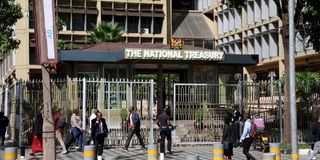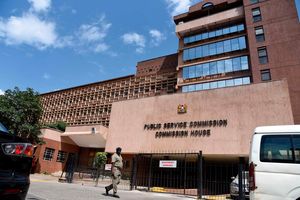
The National Treasury building.
A Sh253 billion revenue shortfall, barely two months from the end of the current financial year on June 30, 2025, points to heightened borrowing in the medium term to plug financing holes.
Documents submitted by the National Treasury show that the Kenya Revenue Authority (KRA) collected Sh2.26 trillion by April against a target of Sh2.51 trillion.
“We have prepared the supplementary estimates III to accommodate the changes and align the budget with the new developments,” National Treasury Cabinet Secretary John Mbadi in a memorandum to the Supplementary Budget III budget tabled in Parliament.
The missed revenue targets have seen the government review the ordinary revenue target downwards to Sh2.49 trillion from the projected Sh2.58 trillion in the supplementary estimates III before the National Assembly with the Appropriation in Aid (AiA) projected at Sh489 billion.
Mr Mbadi attributes KRA’s below-target performance to a shortfall registered in the collection of ordinary revenue by Sh195.3 billion and a shortfall in AiA of Sh57.7 billion.
The shortfall means that the government cannot increase taxes to finance the government operations, but has the only available option of borrowing locally and in the international market. This will see the country’s fiscal deficit hit Sh797.7 billion.
This is despite the government's assurances that it intends to live within the Sh761 billion budget deficit for the current period- 2024/25 as approved by the National Assembly in July 2024 and carried in the Supplementary Appropriation Act 2024.
On March 9, 2025, National Treasury Principal Secretary Chris Kiptoo revealed to the House’s Finance and National Planning Committee that the government had overshot its domestic borrowing for the current financial year by Sh220 billion.
This is well beyond the Sh263.2 billion limit approved by the National Assembly in July 2024.
This means that to finance the deficit, by June 30, 2025, when the current financial year ends, the national government would have borrowed Sh441.8 billion from the foreign market and Sh355.9 billion from the local market, a move that will compound the country’s public debt.
As of December 31, 2024, the National Treasury in its 2025 Medium Term Debt Management Strategy submitted to parliament shows that the country’s public debt stood at Sh10.6 trillion.
This represented 63 percent of GDP against the benchmark debt threshold of 55 percent of debt to GDP with the National Treasury having until November 1, 2028, to bring the present value of public debt to within the threshold.
The Sh10.6 trillion includes Sh5.2 trillion in domestic loans and Sh5.4 trillion in loans from foreign markets.
The increased borrowing goes against the National Treasury’s own commitments to minimise the costs and risks of public debt by mobilising resources mainly from multilateral and bilateral development partners.
“Commercial borrowing sources will be utilised as a last resort to fund the fiscal deficit and repay maturing external debts. Net domestic financing requirements will be met through the issuance of Treasury bonds in the domestic market,” the 2024 Budget Policy Statement approved by parliament noted.
“More emphasis will be on maximising concessional loans while non-concessional borrowing will be limited to economic enabler projects that cannot secure concessional financing and are in line with the Bottom-Up Transformation Agenda of the government.”
The Budget Policy Statement is a government document that highlights the government’s expenditure projections in a financial year.





